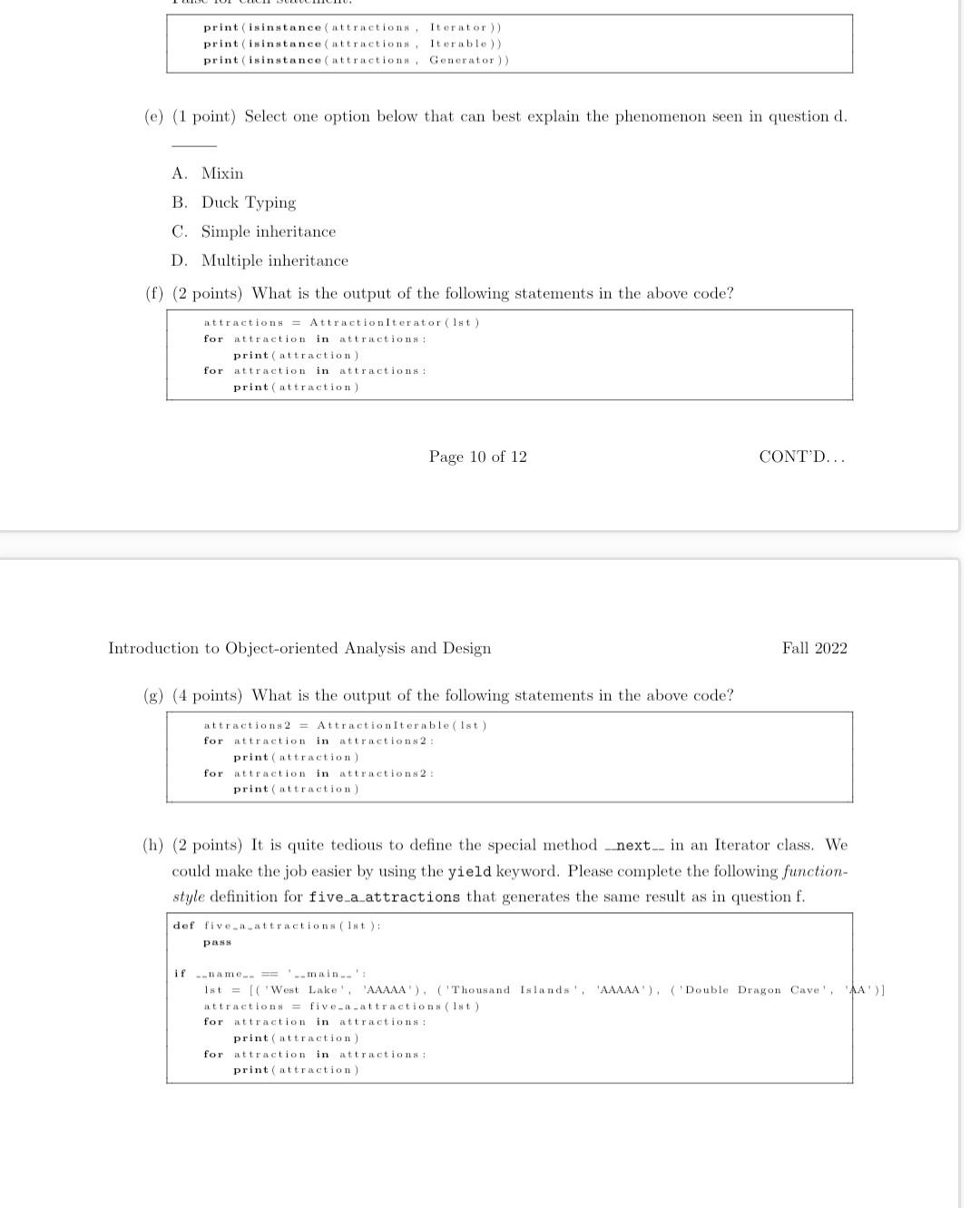Answered step by step
Verified Expert Solution
Question
1 Approved Answer
print(isinstance(attractions,print(isinstance(attractions,Generator))Tterable)) (e) (1 point) Select one option below that can best explain the phenomenon seen in question d. A. Mixin B. Duck Typing C. Simple


print(isinstance(attractions,print(isinstance(attractions,Generator))Tterable)) (e) (1 point) Select one option below that can best explain the phenomenon seen in question d. A. Mixin B. Duck Typing C. Simple inheritance D. Multiple inheritance (f) (2 points) What is the output of the following statements in the above code? \begin{tabular}{l} attractions = Attractioniterator (lst) \\ for attraction in attractions: \\ for attraction in attractions: \\ print(attraction) \\ \hline \end{tabular} Page 10 of 12 CONT'D... ntroduction to Object-oriented Analysis and Design Fall 2022 (g) (4 points) What is the output of the following statements in the above code? attractions 2= Attractioniterable(tst) for attraction in attractions2: for attraction in attractions2: print(attraction) (h) (2 points) It is quite tedious to define the special method _next_- in an Iterator class. We could make the job easier by using the yield keyword. Please complete the following functionstyle definition for five_a_attractions that generates the same result as in question f. print(isinstance(attractions,Iterator))print(isinstance(attractions,Iterable))print(isinstance(attractions,Generator)) (e) (1 point) Select one option below that can best explain the phenomenon seen in question d. A. Mixin B. Duck Typing C. Simple inheritance D. Multiple inheritance (f) (2 points) What is the output of the following statements in the above code? \begin{tabular}{|l} \hline attractions = Attractioniterator(lst) \\ for attraction in attractions: \\ for print(attraction) \\ print(attraction) \\ \hline \end{tabular} Page 10 of 12 CONT'D... Introduction to Object-oriented Analysis and Design Fall 2022 (g) (4 points) What is the output of the following statements in the above code? print(isinstance(attractions,print(isinstance(attractions,Generator))Tterable)) (e) (1 point) Select one option below that can best explain the phenomenon seen in question d. A. Mixin B. Duck Typing C. Simple inheritance D. Multiple inheritance (f) (2 points) What is the output of the following statements in the above code? \begin{tabular}{l} attractions = Attractioniterator (lst) \\ for attraction in attractions: \\ for attraction in attractions: \\ print(attraction) \\ \hline \end{tabular} Page 10 of 12 CONT'D... ntroduction to Object-oriented Analysis and Design Fall 2022 (g) (4 points) What is the output of the following statements in the above code? attractions 2= Attractioniterable(tst) for attraction in attractions2: for attraction in attractions2: print(attraction) (h) (2 points) It is quite tedious to define the special method _next_- in an Iterator class. We could make the job easier by using the yield keyword. Please complete the following functionstyle definition for five_a_attractions that generates the same result as in question f. print(isinstance(attractions,Iterator))print(isinstance(attractions,Iterable))print(isinstance(attractions,Generator)) (e) (1 point) Select one option below that can best explain the phenomenon seen in question d. A. Mixin B. Duck Typing C. Simple inheritance D. Multiple inheritance (f) (2 points) What is the output of the following statements in the above code? \begin{tabular}{|l} \hline attractions = Attractioniterator(lst) \\ for attraction in attractions: \\ for print(attraction) \\ print(attraction) \\ \hline \end{tabular} Page 10 of 12 CONT'D... Introduction to Object-oriented Analysis and Design Fall 2022 (g) (4 points) What is the output of the following statements in the above code
Step by Step Solution
There are 3 Steps involved in it
Step: 1

Get Instant Access to Expert-Tailored Solutions
See step-by-step solutions with expert insights and AI powered tools for academic success
Step: 2

Step: 3

Ace Your Homework with AI
Get the answers you need in no time with our AI-driven, step-by-step assistance
Get Started


